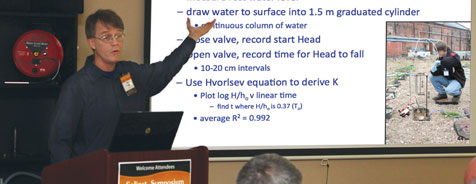
Ryan Wilson used the SABRE project to base his discussion on treatment performance assessment (PA). According to Ryan, PA is about asking questions: Is the treatment working? Why or why not? Is risk reduced? When can treatment stop? Are processes sustainable? Is sufficient mass reduced? What do trends indicate? How can we optimize treatment? How reliable are estimates?
Ryan looked at the use of long screened wells and multilevel well transects at the SABRE site, and what information each monitoring approach provided for answering the above questions.
Two conventional long screened monitoring wells were placed down gradient of each other. The chemical concentrations found the in groundwater was different in each well, which was an indication they were not on the same flow path. The wells did provide some insight on the biogeochemical processes involved in the remediation and did indicate temporal trends, but the quantitative data had a lot of uncertainty associated.
Two multilevel transects were used on site, one in the source zone and the other in the plume zone. The multilevel transects showed the spatial distribution of the contamination. They were also used to make estimates of mass discharge and uncertainty. Instead of using a uniform velocity for the entire site, hydraulic conductivities measured at each multilevel port were combined with point concentration measurements to give mass discharge estimates with reduced uncertainty.
Ryan stressed, that an accurate performance assessment requires multiple lines of evidence including qualitative, semi-quantitative, and quantitative. Using both conventional monitoring and multilevel well samplers provides the data needed to assess and manage remediation projects, and reduce uncertainty in estimates of the remediation progress.

ABOUT THE SPEAKER – Ryan Wilson, Ph.D.
AMEC
Dr. Wilson has 18 years of groundwater contamination assessment and remediation experience, primarily as an academic investigator. He received his MSc and PhD from the University of Waterloo (Earth Science), and recently joined AMEC after an 8-year stay at the University of Sheffield, UK. His research has focused primarily on field investigations of the fate, transport and remediation of petroleum hydrocarbons and chlorinated solvents. Recent research interests include coal tar behaviour and recovery, controls on LNAPL wetting phenomena, biodegradation of high concentration organics, and application of char PRBs for treatment of metals. Research highlights include the first demonstration of direct DNAPL detection using partitioning tracers, one of the earliest demonstrations of MTBE biodegradation by indigenous bacteria, and is a co-inventor of the Waterloo Emitter(tm). He has over 50 publications, including 20 in peer-reviewed journals.
